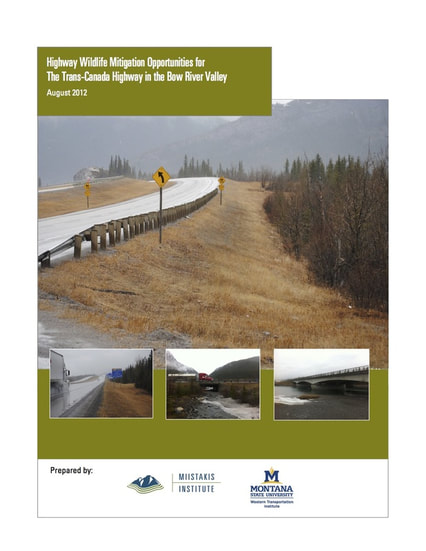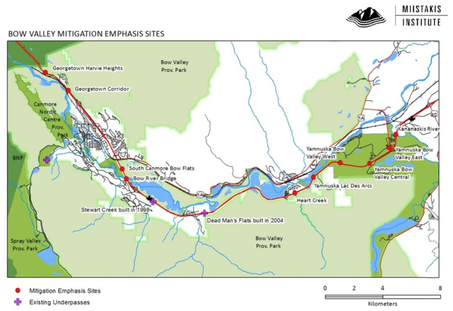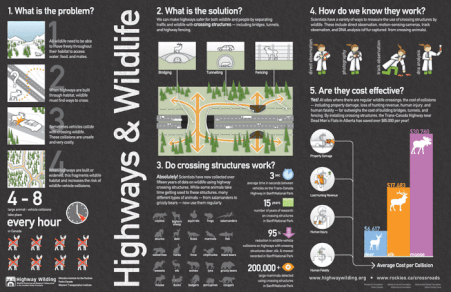What is road ecology?
Road Ecology is the study of interactions between the environment and roads. The field examines and addresses the effects of roads on wildlife populations and investigates how roads influence ecological processes. Roads threaten wildlife through habitat loss, fragmentation, degradation and direct mortality (wildlife-vehicle collisions). They create a barrier to wildlife migration, affecting ecological connectivity— denying wildlife access to resources and potentially leading to reduced genetic and species diversity.
The A2A corridor is a multi-use region with many roads; to achieve our mission to promote ecological integrity and resilience in the region, we need to minimize the direct and indirect effects that these roads have on wildlife. That is why A2A has been working on projects to help reduce wildlife road mortality across the entire Algonquin to Adirondacks region by making recommendations on the best possible locations for wildlife crossings. Along with our partners, A2A has completed a collaborative road ecology study on major highways in Eastern Ontario and is currently studying major highways directly south of the Ontario study area in Northern New York. The results of the Canadian studies demonstrate that these highways cause substantial wildlife mortality, and they impede the movement of wildlife between Canada and the United States.
Historically, this area provided the best opportunity for wildlife to move between two massive ‘core’ natural areas – Algonquin Provincial Park in Ontario and Adirondacks State Park in New York. As such, A2A’s goal is to create and implement innovative strategic recommendations to re-establish connectivity across this disruptive highway corridor, and to restore the ability of wildlife to move between the two countries. One method to re-establish connectivity across highway corridors is through wildlife crossings, and A2A has looked at international case studies to aid in our strategic recommendations. An article regarding animal crossings being used around the world can be found here. This road ecology project is the first of its kind in working to restore the ability of wildlife to move between these two core natural areas.
The A2A corridor is a multi-use region with many roads; to achieve our mission to promote ecological integrity and resilience in the region, we need to minimize the direct and indirect effects that these roads have on wildlife. That is why A2A has been working on projects to help reduce wildlife road mortality across the entire Algonquin to Adirondacks region by making recommendations on the best possible locations for wildlife crossings. Along with our partners, A2A has completed a collaborative road ecology study on major highways in Eastern Ontario and is currently studying major highways directly south of the Ontario study area in Northern New York. The results of the Canadian studies demonstrate that these highways cause substantial wildlife mortality, and they impede the movement of wildlife between Canada and the United States.
Historically, this area provided the best opportunity for wildlife to move between two massive ‘core’ natural areas – Algonquin Provincial Park in Ontario and Adirondacks State Park in New York. As such, A2A’s goal is to create and implement innovative strategic recommendations to re-establish connectivity across this disruptive highway corridor, and to restore the ability of wildlife to move between the two countries. One method to re-establish connectivity across highway corridors is through wildlife crossings, and A2A has looked at international case studies to aid in our strategic recommendations. An article regarding animal crossings being used around the world can be found here. This road ecology project is the first of its kind in working to restore the ability of wildlife to move between these two core natural areas.
Road Ecology Update:
The Research stage of the A2A Road Ecology work is now complete - 401 and Hwy 2 reports are available. A2A is continuing to build on the previous road ecology work on Highway 401. See the 401 Report here. Through additional funding from the Ontario Ministry of Natural Resources and Forests , A2A has now assessed road ecology along the Highway 2 corridor - in partnership with Queen's University. The most recent report on Highway 2 is available here. Next up is the identification of priority crossing areas, mitigation measures, and outreach with municipalities, road authorities, and landowners. This began with a project in partnership with the 1000 Islands National Park looking at hot spots and landscape features in the Park area to identify priority areas for mitigation. See a summary of this work on pages 8-9 of our 2019 Annual Report.
A2A Road Ecology Studies:
The Research stage of the A2A Road Ecology work is now complete - 401 and Hwy 2 reports are available. A2A is continuing to build on the previous road ecology work on Highway 401. See the 401 Report here. Through additional funding from the Ontario Ministry of Natural Resources and Forests , A2A has now assessed road ecology along the Highway 2 corridor - in partnership with Queen's University. The most recent report on Highway 2 is available here. Next up is the identification of priority crossing areas, mitigation measures, and outreach with municipalities, road authorities, and landowners. This began with a project in partnership with the 1000 Islands National Park looking at hot spots and landscape features in the Park area to identify priority areas for mitigation. See a summary of this work on pages 8-9 of our 2019 Annual Report.
A2A Road Ecology Studies:
- Hwy 401
- Hwy 2
- Highway 401 Porosity Study, prepared by Don Ross of the Frontenac Arch Biosphere
Solutions to help wildlife cross the Trans-Canada Highway in the Bow Valley
Miistakis in partnership with the Western Transportation Institute has completed a study that evaluated the best locations to mitigate the effect of the TCH within the Bow Valley on the local wildlife populations and provide for reductions in wildlife-vehicle collisions (WVCs). In addition, the study conducted cost-benefit analyses to show where investments in mitigation may provide a net savings to society. The study was funded by the G8 Legacy Grant administered by Alberta Ecotrust Foundation.
The total number of WVCs for the study section between 1998 and 2010 was 806 or an average of 62 WVCs per year. This amounts to an average cost-to-society of $640,922 per year due to motorist crashes with large wildlife, primarily ungulates. Results indicate there are ten sites where mitigation measures would address a combination of values: local and regional conservation needs, high WVC rates, land security (can’t be developed) where mitigation measures are made, and mitigation options that make good sense and were not engineering challenges. Five of the ten mitigation sites had average annual costs exceeding $20,000 per year due to WVCs making each of these an excellent candidate for cost effective mitigation measures. The report provides each mitigation site with its own particular blend of recommendations for how best to mitigate the effect of the TCH on the local wildlife populations.
An analysis of a wildlife underpass with fencing at a 3 km section of the TCH within the project area near Dead Man’s Flats showed that total WVCs dropped from an annual average of 11.8 per-construction to an annual average of 2.5 WVCs post-mitigation construction. The wildlife crossings and fencing reduced the annual average cost by over 90%, from an average of $128,337 per year to a resulting $17,564 average per year. These results highlight the cost effectiveness of highway mitigation at Dead Man’s Flats.
Download Report: Lee, T., Clevenger, A. and R. Ament. 2012. Highway Wildlife Mitigation Opportunities for the Trans Canada Highway in the Bow Valley. Final Report. G8 Legacy Fund, Alberta Ecotrust Foundation. 72pp.
Reprinted from the Miistakis Institute
The total number of WVCs for the study section between 1998 and 2010 was 806 or an average of 62 WVCs per year. This amounts to an average cost-to-society of $640,922 per year due to motorist crashes with large wildlife, primarily ungulates. Results indicate there are ten sites where mitigation measures would address a combination of values: local and regional conservation needs, high WVC rates, land security (can’t be developed) where mitigation measures are made, and mitigation options that make good sense and were not engineering challenges. Five of the ten mitigation sites had average annual costs exceeding $20,000 per year due to WVCs making each of these an excellent candidate for cost effective mitigation measures. The report provides each mitigation site with its own particular blend of recommendations for how best to mitigate the effect of the TCH on the local wildlife populations.
An analysis of a wildlife underpass with fencing at a 3 km section of the TCH within the project area near Dead Man’s Flats showed that total WVCs dropped from an annual average of 11.8 per-construction to an annual average of 2.5 WVCs post-mitigation construction. The wildlife crossings and fencing reduced the annual average cost by over 90%, from an average of $128,337 per year to a resulting $17,564 average per year. These results highlight the cost effectiveness of highway mitigation at Dead Man’s Flats.
Download Report: Lee, T., Clevenger, A. and R. Ament. 2012. Highway Wildlife Mitigation Opportunities for the Trans Canada Highway in the Bow Valley. Final Report. G8 Legacy Fund, Alberta Ecotrust Foundation. 72pp.
Reprinted from the Miistakis Institute
© 2024 Algonquin to Adirondacks Collaborative
A2A is a 149(1)(f) registered Canadian charity | BN: 86307 1668 RR0001 | and a 501(c)(3) tax-exempt organization in the U.S. | IRS #86-1358996 |
Become a Member | Maps & Region | FAQs | Donate Online | Contact Us
A2A is a 149(1)(f) registered Canadian charity | BN: 86307 1668 RR0001 | and a 501(c)(3) tax-exempt organization in the U.S. | IRS #86-1358996 |
Become a Member | Maps & Region | FAQs | Donate Online | Contact Us



